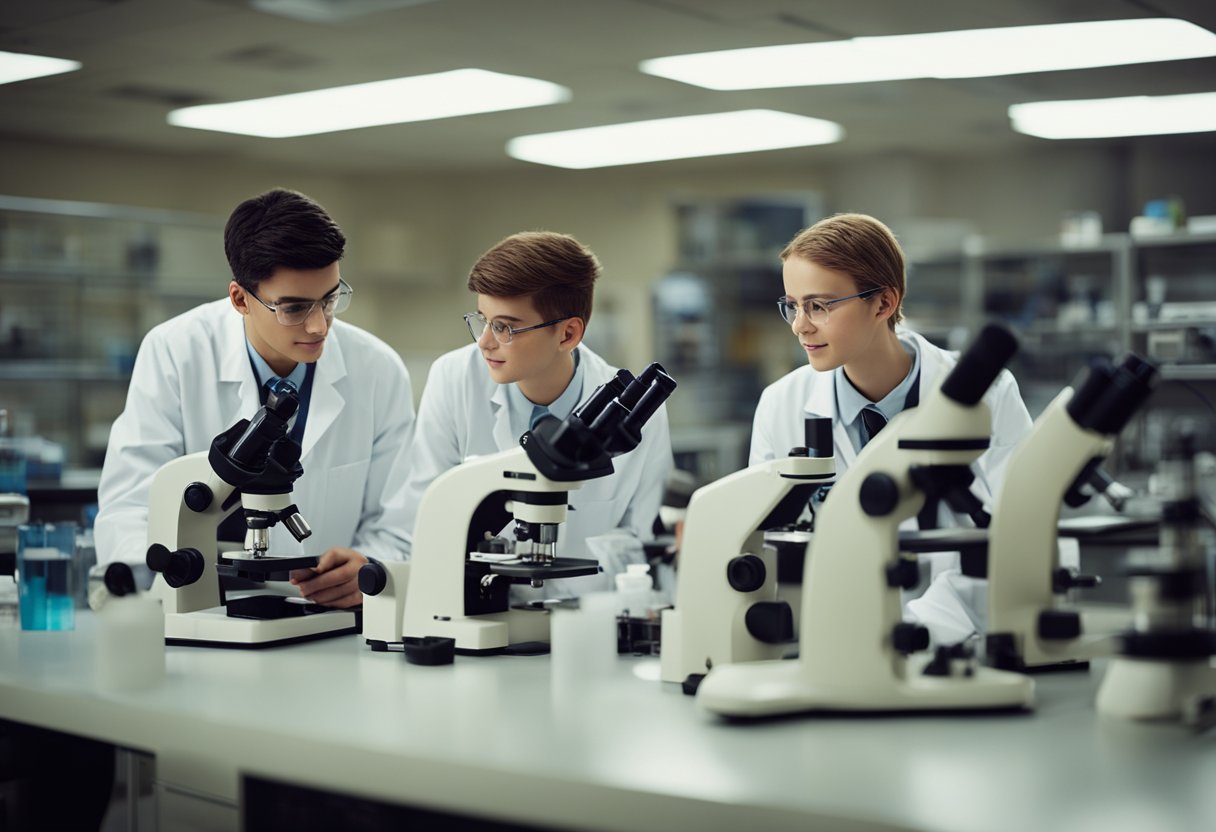After-school science programs are a significant addition to the standard curriculum, providing students with an opportunity to deepen their understanding of science outside of the regular school hours. These programs are designed to foster a love for learning and fuel curiosity in young minds. By participating in hands-on activities and experiments, students can grasp complex scientific concepts in a fun and interactive environment.

These enriching programs not only reinforce scientific knowledge but also encourage critical thinking and problem-solving skills. They are tailored to cater to various age groups, ensuring that the content is appropriate and engaging for everyone involved. With a focus on STEM subjects—science, technology, engineering, and mathematics—after-school science programs provide children with the tools and knowledge required to excel in an increasingly technology-driven world.
Key Takeaways
- After-school science programs enhance learning and passion for science.
- They offer interactive, age-appropriate content that emphasizes critical thinking.
- Such programs prepare students for future educational and career opportunities in STEM fields.
The Importance of Science in After-School Programs
After-school programs enrich your education by providing opportunities that regular school hours may not offer, particularly in the realm of science. They serve to expand your knowledge and foster abilities that are essential in a rapidly advancing world.
https://www.youtube.com/watch?v=euZQYVul0js&embed=true
Benefits of Hands-On Learning
You’ll find that hands-on learning in science is vital to solidifying your understanding of theoretical concepts. By actively engaging in experiments and projects, you see science in action, which makes learning both educational and fun. This type of learning can enhance your retention of information and provides the added benefit of making you a happy customer of the learning process.
Fostering Creativity and Problem-Solving
Creativity and problem-solving are cornerstones of scientific inquiry. After-school programs often include activities that require you to think outside the box and apply your knowledge in creative ways. This not only boosts your problem-solving skills but also prepares you to tackle real-world challenges with confidence.
Program Structure and Content
https://www.youtube.com/watch?v=sA0lPWyQTyA&embed=true
High-quality after-school science programs excel by blending a robust selection of topics and dynamic, hands-on activities that reinforce crucial educational outcomes.
Diverse Science Topics
Your program should encompass a wide array of science topics to cater to a broad range of interests and to spark curiosity in various fields. Chemistry and biology serve as foundational subjects, allowing students to explore everything from the properties of polymers to the intricacies of living organisms. Introducing engineering and technology can further empower their creativity, as they delve into the mechanics of energy, forces, and flight. This multidisciplinary approach ensures that every child can find a topic that resonates with them, stimulating their higher-level thinking and attention to detail within the realm of science.
Engaging Activities for Kids
To truly captivate young minds, your program’s content must be engaging. Incorporate a mix of:
- Experiments: For biology and chemistry, simple yet impactful experiments can illustrate how catalysts work or the versatility of polymers.
- Building Projects: Concepts like forces and flight are ideal for engineering challenges.
- Tech-Based Tasks: Integrate technology sessions where kids program simple robots or design digital models, underlining the importance of engineering in everyday life.
This hands-on approach not only solidifies the theoretical knowledge but also keeps the learning environment energetic and fun.
Educational Outcomes
Structured activities lead to meaningful educational outcomes. Your after-school science program should aim for tangible improvements such as:
- Critical Thinking: Participants learn to approach problems methodically, evaluating hypotheses and outcomes.
- Focus: The intricate nature of scientific experiments demands careful attention to detail.
- Scientific Literacy: Through exposure to diverse subjects, students become conversant in scientific terminology and principles, from energy transformation to technology applications.
By emphasizing these outcomes, you prepare students with the cognitive tools necessary for academic success and instill a lifelong appreciation for the sciences.
Logistics and Implementation

When setting up an after-school science program, you must consider how logistics and implementation can influence its success. This includes finding an appropriate location, determining scheduling and pricing, and ensuring safety through proper instructor training.
Finding the Right Location
Your choice of location is crucial for the program’s accessibility and relevance. Schools often offer suitable facilities that students are already familiar with, making transportation and coordination more manageable. Look for spaces like labs or classrooms that are equipped for scientific experiments. If school facilities are unavailable, search for local community centers or libraries that can host your program.
Scheduling and Pricing
Scheduling your program should balance between school hours and home commitments. You may consider a lunch time program to maximize participation without intruding on family time. Additionally, the pricing structure needs careful thought; it should cover your costs while remaining affordable to encourage inclusivity. Offer tiered pricing or scholarships to accommodate varying financial situations.
Safety and Instructor Training
Ensure your program is safe by adhering to all relevant health and safety guidelines. This includes proper storage of materials, supervision ratios, and emergency procedures. Instructors should be well-trained not just in scientific subject matter but also in safety protocols and child engagement strategies. Consider conducting regular training sessions to keep staff updated on the latest educational and safety practices.
Interactive Elements and Take-Home Materials

After-school science programs have increasingly integrated interactive elements and take-home materials to enhance your child’s learning experience. These components support the reinforcement of scientific concepts outside of the classroom.
Program Themed Kits
Many after-school programs like Mad Science offer program themed kits that align with the subject matter of the session. Your child might explore astronomy with a mini telescope kit or delve into biology with a DIY plant-growing kit. These kits often include:
- Materials: Everything necessary to complete projects.
- Instructions: Step-by-step guides that are both educational and easy to understand.
Hands-On Experiments
Hands-on experiments are a core aspect of these programs. For example, sessions offered by Science Explorers provide interactive, hands-on activities where children can engage in learning through doing. This approach typically includes:
- Active Participation: Your child isn’t just watching; they’re doing.
- Engagement: By handling materials and performing experiments, your child’s interest in science is piqued.
Furthermore, many of these programs culminate with a take-home toy or gadget that reinforces the day’s lesson. Be it slime from a chemistry experiment or a simple robot built during an electronics lesson, these take-home items serve as a fun reminder of what was learned.
By bringing home these materials, your child continues the learning process through play and exploration, which can instill a deeper understanding and appreciation for science.
Extending Learning Beyond the Program

Afterschool science programs are critical for enhancing your STEM education. The true value lies in taking what you learn beyond the program’s structured time.
Integration with School Curriculum
Your participation in afterschool science programs can be more impactful if the content aligns with your school curriculum. This synergy allows you to transfer knowledge and skills seamlessly between school and the program. For example, if you’re studying ecosystems in class, an afterschool program focused on biology can offer hands-on activities like water testing at local ponds, reinforcing your classroom learning.
Practical Tip:
- Align Topics: If you’re learning about robotics, participate in a program that builds on that topic through museum exhibits or interactive workshops.
Continued Learning at Home
Afterschool science programs should not be seen as a standalone experience. Extending learning to your home environment can solidify the concepts and skills you’ve gained. This may include science kits or design projects that you can work on with your family, turning theoretical knowledge into real-world applications.
Home Activities:
- Engage in DIY experiments related to recent program topics.
- Visit online resources or virtual museum tours to explore further within the STEM fields.
Remember: Your learning is not confined to the program’s schedule. Every moment at home is an opportunity to deepen your understanding and fuel your passion for science.
Success Stories and Testimonials

When you engage with after-school programs, especially those focused on Mad Science, you’re stepping into a world where young inventors and scientists between the ages of 5-12 come alive with curiosity and achievement.
Crazy ChemWorks sessions are often a hit with kids, where the melding of education and entertainment yields astonishing results. Young participants get hands-on experience with gooey slimes and fizzing reactions, catalyzing both joy and learning.
-
Satisfied Parent: “Fairytale STEAM Camp was awesome! My child couldn’t wait to share what they had created each day.”
- Experience: Positive educational environment
- Impact: Enhanced creative thinking
-
Educator’s Point of View: At a local school, a teacher noted, “Students’ engagement skyrocketed with the Nutty Scientists program.”
-
Community Impact: Successful projects like paper speakers echo the importance of integrating STEM activities beyond the classroom.
What stands out in these programs are the happy customers—parents witnessing their children’s exuberance and growth. Whether it’s from a paper speaker or a bubbling potion, the joy of learning resonates deeply.
Remember, every exciting experiment and all the laughter in these after-school settings contribute crucially to children’s development in science and beyond.
Frequently Asked Questions
Before diving into afterschool science programs, it’s essential to understand the options available and how they can complement your child’s learning. This section covers common inquiries about these educational opportunities.
How can I find free after-school science programs in my area?
You can search for free after-school science programs by checking with local schools, community centers, and educational non-profits. Often, these organizations partner with science and technology initiatives to provide no-cost learning opportunities for children.
What types of activities are typically included in a Mad Science show?
A Mad Science show typically includes a range of interactive activities such as hands-on experiments, science demonstrations, and theatrical presentations that aim to make learning fun and engaging for children.
Which STEM programs are available for elementary students?
There are numerous STEM programs available for elementary students, including coding clubs, robotics workshops, and science fairs. Some programs may also align with national education standards to further complement school-based STEM education.
What is the registration process for Mad Science programs?
To register for Mad Science programs, you’ll need to complete the registration form and make a payment at the time of registration. This can typically be done online, over the phone, or by mailing a check.
What are some examples of after-school science experiments for children?
Examples of after-school science experiments for children include creating a volcano with baking soda and vinegar, constructing simple circuits, or exploring the principles of flight with paper airplane designs.
How do after-school programs benefit students’ education and development?
After-school programs can play a vital role in enhancing students’ education and development by providing additional learning opportunities, promoting critical thinking, and fostering a love for science and technology outside the traditional classroom setting.
